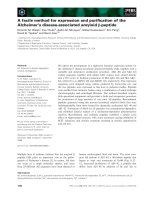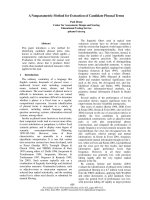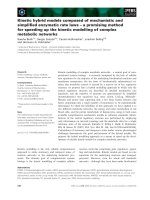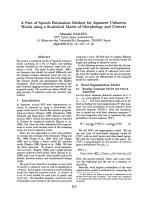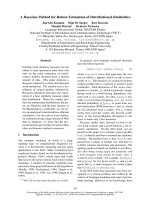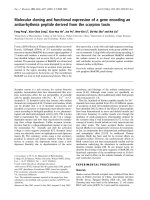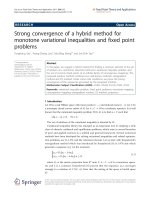Investigation of a simple method for extraction c phycocyanin from the blue green microalgae arthrospira platensis
Bạn đang xem bản rút gọn của tài liệu. Xem và tải ngay bản đầy đủ của tài liệu tại đây (1.77 MB, 64 trang )
VIETNAM NATIONAL UNIVERSITY OF AGRICULTURE
FACULTY OF BIOTECHNOLOGY
------- -------
GRADUATION THESIS
TITLE:
“INVESTIGATION OF A SIMPLE METHOD FOR
EXTRACTION C-PHYCOCYANIN FROM THE BLUEGREEN MICROALGAE ARTHROSPIRA PLATENSIS”
Hanoi, January 2023
VIETNAM NATIONAL UNIVERSITY OF AGRICULTURE
FACULTY OF BIOTECHNOLOGY
------- -------
GRADUATION THESIS
TITLE:
“INVESTIGATION OF A SIMPLE METHOD FOR
EXTRACTION C-PHYCOCYANIN FROM THE BLUEGREEN MICROALGAE ARTHROSPIRA PLATENSIS”
Student name
: Duong Le Long
Student code
: 637042
Class
: K63CNSHE
Faculty
: Biotechnology
Supervisor
: Assoc.Prof.Dr. Nguyen Duc Bach
Hanoi, January 2023
COMMITMENT
This thesis has not been submitted for academic credit at any other higher
education institution. I declare that the work presented in this thesis is original
and solely my own. To my knowledge, the contents of this thesis do not include
any previously published material unless appropriately cited.
Hanoi, January 10th, 2023
Student
Duong Le Long
i
ACKNOWLEDGEMENTS
First of all, I extend my sincere gratitude to the director of the Vietnam
National University of Agriculture, the board of deans, and all the instructors in
the Faculty of Biotechnology for providing me with the opportunity to complete
this thesis.
During my graduation thesis completion, I would like to extend my sincere
appreciation to my thesis advisor, Assoc. Prof. Dr. Nguyen Duc Bach - Director
of the Institute for Microalgae and Pharmacosmetics, Viet Nam National
University of Agriculture, for providing me with invaluable support and
guidance throughout my academic pursuits. Their dedication, thoughtfulness,
and expertise played a significant role in ensuring the success of my thesis.
At the same time, I would like to thank the staff who are studying and doing
research at the Institute for Microalgae and Pharmacosmetics for their
enthusiastic guidance and support during the process of making my thesis
graduation project.
Finally, I would like to extend my sincere gratitude to my parents, siblings,
relatives, and friends for their unwavering support, blessings, and constant
source of inspiration throughout my academic journey.
Once again, thank you for everything!
Sincerely,
Hanoi, January 10th, 2023
Student
Duong Le Long
ii
CONTENTS
CHAPTER 1. INTRODUCTION ......................................................................... 1
1.1. Preface................................................................................................... 1
1.2. Objectives ............................................................................................. 2
1.3. Requirements ........................................................................................ 2
CHAPTER 2. LITERATURE REVIEW .............................................................. 3
2.1. An overview of Arthrospira platensis .................................................. 3
2.1.1. Introduction about Arthrospira platensis ....................................... 3
2.1.2. Taxonomy of Arthrospira platensis ............................................... 4
2.1.3. Chemical composition of the algae Arthrospira platensis ............. 6
2.1.4. The applications of Arthrospira platensis ..................................... 9
2.1.4.1. For human health .................................................................................9
2.1.4.2. In the cosmetics industry ................................................................. 10
2.1.4.3. Some studies show positive results ................................................. 10
2.2. An overview of C-phycocyanin .......................................................... 11
2.2.1. Introduction about C-phycocyanin ............................................... 11
2.2.2. Characteristics of C-phycocyanin ................................................. 12
2.2.3. Applications of C-phycocyanin .................................................... 13
2.2.4. Some studies on the use of C-phycocyanin .................................. 14
2.3. Studies on C-phycocyanin extract in the world and Vietnam ............ 18
2.3.1. Studies on C-phycocyanin extract in the World ........................... 18
2.3.2. Studies on C-phycocyanin extract in Vietnam ............................. 18
CHAPTER 3: MATERIALS AND EXPERIMENTAL METHODS ................ 20
iii
3.1. Materials ............................................................................................. 20
3.1.1. The origin ...................................................................................... 20
3.1.2. Place and time of experiment ....................................................... 20
3.2. Chemicals and equipments ................................................................. 20
3.3. Research methods ............................................................................... 21
3.3.1. Extraction method of C-PC .......................................................... 21
3.3.2. Factors affecting the extraction of C-PC ...................................... 23
3.3.3. Investigate the method of processing C-PC solution into dry
powder .................................................................................................... 24
3.3.3.1. Treatment of C-PC solution into dry powder by freeze-drying
method ................................................................................................................... 24
3.3.3.2. Treatment of C-PC solution into dry powder by natural
evaporation method .............................................................................................. 25
3.3.4. Analytical method ......................................................................... 26
3.3.5. Data processing method ................................................................ 26
CHAPTER 4: RESULTS AND DISCUSSION ................................................. 27
4.1. The results of selecting the optimal conditions for the extraction
process ...................................................................................................... 27
4.1.1. Choose the optimal solvent........................................................... 27
4.1.2. Choose the optimal salt concentration .......................................... 33
4.1.3. Choose the optimal extraction time .............................................. 36
4.1.4. Choose the ratio of algae biomass-solvent volume ...................... 38
4.2. Survey results on the method of processing C-PC solution into dry
powder ...................................................................................................... 42
iv
4.2.1. Experiment results images ............................................................ 42
4.2.2. The quality comparison between freeze-drying method and natural
drying ...................................................................................................... 43
4.2.3. Recovery efficiency of the refining process ................................. 44
CHAPTER 5: CONCLUSION AND SUGGESTION ....................................... 46
5.1. Conclusion .......................................................................................... 46
5.2. Suggestion ........................................................................................... 46
REFERENCES ................................................................................................... 48
v
LIST OF TABLES
Table 2.1. Scientific classification of Arthrospira platensis ................................ 4
Table 2.2. Amino acid composition in Arthrospira platensis .............................. 7
Table 2.3. Vitamin composition in Arthrospira platensis .................................... 8
Table 2.4. Pigmentation composition in Arthrospira platensis ............................ 9
Table 3.1. List of equipments used in the experiment ........................................ 20
Table 4.1. Survey results of C-PC extraction with different solvents ................ 30
Table 4.2. Survey results of C-PC extraction at different salt concentrations ... 33
Table 4.3. Survey results of C-PC extraction over time course ......................... 36
Table 4.4. Survey results of C-PC extraction with different solvent volume
ratios .................................................................................................................... 39
Table 4.5. Investigate the quality of C-PC when using freeze-drying and natural
drying methods.................................................................................................... 44
Table 4.6. Recovery efficiency of the whole process of refining C-PC to powder
form ..................................................................................................................... 45
vi
LIST OF FIGURES
Figure 4.1. Image of C-PC solution after being extracted in different solvents. 28
Figure 4.2. Images of algae structure before and after soaking for 8 hours,
observed under a microscope with 40x magnification ....................................... 29
Figure 4.3. The change of C-PC content according to the solvent ..................... 31
Figure 4.4. The change of purity of C-PC with solvent ..................................... 32
Figure 4.5. The change of C-PC content according to salt concentration .......... 35
Figure 4.6. The change of purity of C-PC with salt concentration..................... 35
Figure 4.7. The change in the content of C-PC over the time course................. 37
Figure 4.8. The change in the purity of C-PC over the time course ................... 38
Figure 4.9. Influence of solvent ratio on the content of extracted C-PC ............ 40
Figure 4.10. Influence of solvent ratio on the purity of extracted C-PC ............ 41
vii
LIST OF ABBREVIATIONS
A. platensis
: Arthrospira platensis
C-PC
: C-phycocyanin
UV-VIS
: Ultravioliet – visible
W/v
: Weight/volume
WHO
: World Health Organization
viii
ABSTRACT
Based on the results of this study on the extraction of C-phycocyanin from
Arthrospira platensis, the mechanical extraction method was found to be a
straightforward and low-cost approach for extracting C-phycocyanin. The study
demonstrated that despite having low concentration and purity, the resulting
product met safety requirements for use. The extraction procedure involved
using 0.9% NaCl buffer, an algal mass-solvent volume ratio of 0.0625, and an
extraction time of 14 hours. The solution was then centrifuged at 1900 rpm for
20 minutes, resulting in a product with a concentration of 3.15 mg/mL and a
purity of A620nm/A280nm = 0.63. The yield of the purification process was 81.2%.
Furthermore, freeze drying was found to be superior to natural evaporation in
producing dry solid products without significantly reducing the quality and
purity of C-phycocyanin. The resulting composition had a C-phycocyanin
content of 3.12 mg/mL and a purity of A620nm/A280nm = 0.61.
Previous studies have also investigated methods for extracting Cphycocyanin from microalgae. A study by H. Dhakal et al., (2018) reported a
maximum yield of 17.3% using ultrasonic-assisted extraction with a mixture of
ethanol and water. Another study by O.P. Ruiz et al., (2019) investigated the
use of a high-pressure homogenization technique and found that it was a
promising method for extracting C-phycocyanin. However, both studies
involved more complex and expensive extraction methods than the mechanical
extraction method used in the current study.
In comparison to the above studies, the mechanical extraction method
described in this study offers a simple and cost-effective approach for extracting
C-phycocyanin from Arthrospira platensis. The study's findings demonstrate the
potential of this method for large-scale production of C-phycocyanin, which has
numerous applications in the food and pharmaceutical industries.
ix
CHAPTER 1. INTRODUCTION
1.1. Preface
From ancient times, people have known how to use nutritious food sources
and natural remedies to eliminate illness and maintain good health. Today, with
the advancement of science and technology, numerous research projects have
been conducted to find rare natural substances with many applications in
medicine. C-phycocyanin (C-PC) is a major component of phycobiliproteins
found in many species of blue-green algae, particularly in Spirulina
(Arthrospira platensis) where it is a pigment with high concentrations. In fact,
many studies have proven its widespread applicability in various fields such as
pharmaceuticals, foods, cosmetics (whitening creams, antioxidants) and even in
medicine including treating cancer.
Although phycocyanin extractions have been performed by many
scientists, many methods have also been proposed since then. However, most of
these methods are still complex and limited to laboratory scale experimentation
and difficult for industrial scale production application. To date, Vietnam has
not been able to actively source phycocyanin for commercial production in the
industry and must import from abroad at a very high price.
Within the framework of this study, I would like to present a simple, safe
and effective method of obtaining phycocyanin and investigate the possibility of
purification into powder form. The content of the study includes: selecting
extraction conditions, preparation, process of refining and preservation of the
product. The expected results of the study will bring significant progress in the
extraction of natural pigments for applications in food, medicine, and industrial
scale production.
1
1.2. Objectives
Finding a method to obtain C-phycocyanin simple, safe, effective
and can be applied in industrial production.
Find out a method to preserve C-phycocyanin into a solid form to
preserve the preparation.
1.3. Requirements
Conducted various experiments to find a simple, efficient extraction
method to obtain the optimal amount of C-phycocyanin. Ensure technical when
conducting experiments, experimental results must be accurate and truthful.
2
CHAPTER 2. LITERATURE REVIEW
2.1. An overview of Arthrospira platensis
2.1.1. Introduction about Arthrospira platensis
Since ancient times, Spirulina (A. platensis) has been considered a perfect
food that has been consumed by humans because it contains high amounts of
good quality protein, lipids, essential minerals, and biologically active
substances such as phycocyanin, beta-carotene, chlorophyll, and gama-linoleic
acid (Z. Khan, et al., 2005). Spirulina also contains many precious pigments
such as vitamins of groups B and E (W.S. Park et al., 2018). In addition,
phycocyanins from Spirulina are mostly consumed as natural edible and
functional colorant due to their brilliant blue color with excellent antioxidant,
anti-cancer, and anti-inflammatory activities (S.M. Hosseini, et al., 2013; J.C.
Lee, et al., 2013). Therefore, Spirulina is researched, produced and applied in
many areas of life, making food functions, essential nutritional supplements and
cosmetics. Spirulina is used as a perfect functional food, recognized by the
WHO as the best food for mankind in the 21st century (N. Seyidoglu et al.,
2017).
Spirulina is a common name for two species of cyanobacteria A. platensis
and A. maxima with a spiral structure, widely distributed in water bodies around
the world. Spirulina can live even in the environment freshwater and saltwater
and thrive in medium rich in bicarbonate and high alkalinity pH from 8.5 – 11
(C. Sili et al., 2012). A. platensis has been harvested for food purposes since
ancient times, it appeared about 3.5 billion years ago. A. platensis was first
described in 1940, by Dangeard, a French phycologist, who received a sample
from a French colleague, in the French Army in equatorial Africa, near presentday Lake Chad. After that, Dangeard published a report it. In 1964, a botanist
on a Belgian Trans-Saharan expedition, Jean Léonard, reported finding a
3
curious greenish, edible cake being sold in native markets of Fort-Lamy (now
N‟Djamena) in Chad (J. Léonard, et al., 1967). These cakes are Arthrospira
platensis algae from Lake Chad and then it dried.
In Vietnam, A. platensis has been studied since the 1970s. After the
1970s, there were many studies on Spirulina. Recently, at the Institute for
Microalgae and Pharmacosmetics, under the research of scientist Nguyen Duc
Bach et al., 2020, they succeeded in applying red LEDs to prolong the
cultivation time of Spirulina in the North of Vietnam. Currently, Vietnam has
many farms formed from the cultivation of A. platensis such as Vinh Hao (Binh
Thuan province), Vnua Pharma company (Hanoi).
2.1.2. Taxonomy of Arthrospira platensis
Table 2.1. Scientific classification of Arthrospira platensis
Scientific classification
Domain
Bacteria
Phylum
Cyanobacteria
Class
Chroobacteria
Order
Oscillatoriales
Family
Phormidiaceae
Genus
Arthrospira
Species: The genus Spirulina has many species, more than 35 species have
been discovered (Le Van Lang, 1999). Among them are the first and most
4
studied 2 species: S. geitleri (S.maxima) – native to Africa, S. platensis – native
to South America. There is also S. prpvilca in Puru, S. jeejibai in Germany, S.
subsalsa in Ukraine, S.laxissima in Kenya, S. pacifica in the United States.
The cell structure of Spirulina platensis was described in figure (2.1), (R.A.
Lewin, 1953). The author observed that the cells of S. platensis are cylindrical
in shape and arranged in filaments, with each cell containing a large central
vacuole. The cell wall of S. platensis is thin and flexible, allowing the cells to
bend and twist in response to water currents.
Figure 2.1. Structure of Spirulina (Arthrospira platensis)
In shape, the algae A. platensis is usually in the form of a spring-type
twist of cyan color with fairly even twists, at the ends of the fibers often
narrowing and sucking. However, due to the conditions of residence and the
period of development, the shape of the algae may change slightly: the algae
fiber extends or twists but the density is thick and the shape is different such as
5
the letter C, the letter SA unique feature that does not change is unbranched,
unbranched and heterocellular algae fibers (S. Boussiba et al., 1979)
In terms of size, adult algae are usually long from 250 1000 m, width
6 8 m, spiral diameter 35 50 m, twisting step 60 m but depending on the
degree of torsion or straightness, this size also varies. In terms of structure, A.
platensis has a multicellular structure with nearly 100 cells per algae fiber. The
cell does not yet have a typical nucleus, nor does the nucleus have clear limits.
(D. Kumar, et al., 2014).
A. platensis does not have chloroplasts but instead thylakoid bodies
arranged in rings containing the pigments chlorophyl, phycocyanin, carotenoids.
Cell membranes also do not have a plant-like cellulose wall, but rather layers of
peptidoglycan that are easily assimilated by digestive enzymes. Because of
these characteristics, A. platensis is classified as a bacteriology, not algae as
before (M.A.B Habib, et al., 2008).
In terms of motor characteristics, A. platensis can be performed in two
ways: free torsion due to the change of shape from torsion to straight or vice
versa; or translational in the aquatic environment as creatures thanks to
cylindrical air cells (D. Kumar, et al., 2014). Their speed of movement can be
reached 5 micron/second. This movement is performed by the hairs on the side
of the body (fimbria) - they are fibers with diameter 5-7 nm and long 1-2
micron lying around the body. These bristles act as paddles for the
cyanobacteria to function (C. D‟souza, et al., 2018).
2.1.3. Chemical composition of the algae Arthrospira platensis
To this day, A. platensis is still considered to be the most nutritionally
complete food found in the world. Contains more than 50 micronutrients, more
than any other food, green vegetables, nuts or herbs (J.C. Dillon, et al., 1995).
6
A.platensis contains about 60% protein (protein) which is a higher source of
texture than beef (18%), poultry (19%), fresh milk (3.7%) and eggs (14%). In
particular, the protein in the algae A. platensis is a synthesis of more than 18
amino acids, of which 8 are essential and all are easily digestible (up to 95%)
due to the nature of vegetable protein (A. Vonshak, 1997).
Table 2.2. Amino acid composition in Arthrospira platensis
Amino acid composition
Content (g/100g)
Alanine
4.0-5.0
Arginine
3.0-5.0
Aspartic acid
1.5-3.0
Cystine
0.5-0.75
Glutamic acid
6.0-9.0
Glycine
2.0-4.0
Histidine
0.5-1.5
Isoleucine
3.0-4.0
Leucine
3.0-5.0
Lysine
3.0-6.0
Methionine
1.0-6.0
Phenyl Alanine
2.5-3.5
Proline
2.0-3.0
Serine
3.0-4.5
Threonine
1.5-3.0
Trytophane
1.0-2.0
Tyrosine
1.0-3.0
Valine
1.0-3.5
Source: The role of Parry Organic Spirulina(A. platensis) in Health
Management October 2010
7
Besides, A. platensis is also a source of many vitamins such as vitamin A,
vitamin E, vitamin B complex (B1, B2, B6, B12) with twice the B12 content of
beef liver, 20 times higher beta-carotene content In carrots, the amount of
vitamin E is twice that of wheat germ. Contains many essential minerals for the
body and bones such as potassium, calcium, magnesium, zinc and rich in
essential fatty acids GLA and fiber ( S.M. Hosseini, et al., 2013).
Table 2.3. Vitamin composition in Arthrospira platensis
Vitamin composition
Content (mg/100g)
Vitamin B1 (Thiamine)
0.15-0.30
Vitamin B2 (Riboflavin)
4.0-7.0
Vitamin B3 (Niacin)
10.0-25.0
Vitamin B6 (Pyridoxine)
0.5-1.5
Vitamin B12 (Analogue)
0.10-0.30
Folic acid
0.05-0.30
Inositol
70-90
Vitamin K
0.90-1.05
Source: The role of Parry Organic Spirulina (A.platensis) in Health
Management October 2010
In addition, A. platensis also contains many important anti-aging
substances (to protect cells) such as phycocyanin, chlorophyll and carotenoids
which have contributed to making A. platensis completely different and unique
compared to other natural (J.C. Dillon, et al., 1995).
8
Table 2.4. Pigmentation composition in Arthrospira platensis
Phytopigments
Content (mg/100g)
Total Carotenoids
400-650
Beta Carotene
150-250
Xanthophylls
250-470
Zeaxanthin
125-200
Chlorophyll
1300-1700
Phycocyanin
15000-19000
Source: The role of Parry Organic Spirulina (Arthrospira platensis) in Health
Management October 2010
2.1.4. The applications of Arthrospira platensis
2.1.4.1. For human health
Unique phytonutrients extracted from the algae A. platensis work to
strengthen the immune system and improve health in several ways (P.D.
Karkos, et al., 2011). Mild detoxification effect in diseases: kidney failure,
hepatitis, lowering cholesterol, alleviating diffuse polyarthritis. Prevention of
atherosclerosis, effective for obesity because A. platensis satisfies the body's
need for hormones, vitamins and minerals before eating, and reduces appetite.
Effective for diabetes, anemia, gastric and duodenal ulcers, pancreatitis,
cataracts, visual impairment, hair loss. Reduces the risk of cancer and is an
adjuvant nutrition for cancer patients after radiation therapy, chemotherapy,
surgery, increasing the kidney's ability to eliminate toxins. Improve metabolism,
limit malnutrition, for athletes, A. Platensis helps to increase physical strength
and endurance.
9
2.1.4.2. In the cosmetics industry
A. platensis has a hormone-regulating effect that helps prolong a woman's
youth. The C-PC present in A. platensis can fight free radicals and inhibit the
production of inflammatory signaling molecules, providing antioxidant and
anti-inflammatory effects. Beta-carotene is a UV blocker, acid W3-protects the
skin, stimulates scar healing, increases wound healing. Polysaccharides have
antibacterial effects and absorb water to create a cooling gel for the skin. The
proteins and amino acids in A. platensis have a skin-nourishing effect.
2.1.4.3. Some studies show positive results
The latest studies have evaluated the ability of A. platensis to inhibit viral
self-replication, enhance cellular and humoral immunity, and limit and destroy
cancer cells. Although these are only preliminary studies, the results obtained so
far are very encouraging (J.C. Lee, et al., 2013).
Anti-cancer effect:
Many studies have shown that: A. platensis and its extracts have the
ability to prevent or inhibit cancer in humans and animals. Some common forms
of cancer often damage the cell's DNA, causing uncontrolled growth of cancer
cells. Cytologists have discovered a special enzyme system called Endonuclease
that is able to repair damaged DNA to protect healthy cells (R. González, et al.,
1999). When these enzymes are inactivated by radioactive or toxic substances,
DNA cannot be restored and cancer develops. In vitro studies have shown that
the unique polysaccharide present in A. platensis can improve the enzyme
activity in the cell nucleus and synthesize/repair damaged DNA (S.P. Kamble,
et al., 2013)
The effect of strengthening the immune system:
10
A. platensis is an immune-boosting herb. Animal studies (rats, chickens,
cats…) show that A.platensis can improve immune system function, stimulate
immunity, and regenerate blood cells. Important components of the immune
system are bone marrow stem cells, macrophages, T lymphocytes, and natural
killer cells. A. platensis increases the number of macrophages, activates them
and increases the efficiency of killing bacteria. Just a small amount of A.
platensis increases the production of fluids and cells of the immune system. A.
platensis increases the production of antibodies and cytokines. The cellular
immune system includes T lymphocytes, B lymphocytes, macrophages, and
natural cancer killer cells. These cells circulate in the blood and are abundant in
the liver, spleen, thymus, lymph nodes, tonsils, and bone marrow. A. platensis
enhances the activity of target cells and tissues, limiting environmental stress,
toxins and bacteria (S. Lee, et al., 2013).
Arthrospira platensis has hematopoietic effects in the human body
C-phycocyanin is a polypeptide that is abundant in A. platensis and acts on
stem cells in the spinal cord. These are the stem cells that make up the cells of
the immune system and the blood cells that supply the body with oxygen.
Another, C-PC has the ability to stimulate hematopoiesis, enhance the effect of
the hormone erythropoetin (EPO). The EPO produced by the kidneys,
stimulates bone marrow stem cells to produce hematopoiesis. C-PC also
stimulates the production of lymphocytes, even when bone marrow stem cells
are destroyed by toxins or radiation (N.T. Eriksen et al., 2008).
2.2. An overview of C-phycocyanin
2.2.1. Introduction about C-phycocyanin
C-phycocyanin is a blue pigment found in cyanobacteria, rhydophyta, and
cryptophyta (M. Kuddus, et al., 2013). This pigment gives cyanobacteria their
bluish color and is also known as cyanobacteria. C-PC is formed by sulfur
11
binding of the Cistein component in the polypeptide sequence with the vinyl
group-bearing carbon of the tetrapyrol phycocyanobilin (C. Romay, et al.,
2003). The structure of C-PC is shown in figure (2.2).
Figure 2.2. Structure of C-phycocyanin
In the structure of Spirulina algae, C-Phyoccyanin is water-soluble and
aggregates into groups and binds to cell membranes to form phycobilisomes
(V.B Bhat, et al., 2003). C-PC is water soluble, has fluorescent properties, and
has antioxidant properties. C-PC and other phycobiliproteins have many
applications
in
food,
cosmetics,
biotechnology,
diagnostics
and
pharmaceuticals.
2.2.2. Characteristics of C-phycocyanin
The blue molecule consists of three or more amino acids linked together
by peptide bridges. Depending on the structure, there are many different groups
of phycobiliproteins. There are three common phycobiliproteins: phycoerythrin
(PE) with phycoerythrobilin pigment, phycocyanin (PC) and allophycocyanin
(APC) with phycocyanobilin pigment (W. Song, et al., 2013). In some
organisms there is not one, but many types of phycobilin. In 1998, the
phycobiliproteins were re-named more explicitly by MacColl, by adding the
12
component phycobilin before the name of each phycobiliprotein. For example,
the phycocyanin with the pigment phycocyanobilin is called C-phycocyanin (CPC). The molecular weight of C-PC is 232000 Dalton. The C-PC pigments have
a maximum visible absorbance that varies between 615 nm and 620 nm and a
maximum emission fluorescence around 652 nm (C. Romay, et al., 2003).
Phycocyanin has a flattened elliptical structure composed of from the α
(size 12,000-18,500 Da) and β (size 14,000-20,000 Da) and in the natural
hexamer form (αb)6. However, it does exist in trimer form (α β)3 and dimer (α
β)2 (R.G. Fisher et al., 1980). The molar mass of monomer is 44 kDa, trimer is
132 kDa and hexamer is 260 kDa. The isoelectric point is 5.8. At this pH value,
the phycobiliprotein will clump and lose its ability to interact with water. The
ability to absorb the strongest spectrum in the wavelength range 615-620 nm,
luminescence at wavelength 647-652 nm and stable at pH 5.0-7.5 and
temperature (25 ± 2 ℃). Outside of this condition, the phycocyanin will lose its
color or become denatured (N.T. Eriksen, et al., 2008).
2.2.3. Applications of C-phycocyanin
Food fillers and functional foods
C-PC extracted from A. platensis is considered a food and cosmetic
colorant in Japan but is still not recognized in many places, such as Europe.
Moreover, C-PC is gradually replacing synthetic color. This pigment is also
used in many fermented dairy products in many countries around the world.
Several studies have shown the function of C-PC in foods as a colorfast and
rheological agent. The C-PC is also used as a nutritional ingredient, especially
in functional foods, dried biomass of A. platensis is used as a functional
ingredient in food. In addition to nutritional value, C-PC also has the effect of
increasing the body's immunity, anti-oxidant, anti-inflammatory, anti-viral, anticancer and lowering blood cholesterol ( Z. Khan, et al., 2005).
13
Nutrition and pharmaceuticals
C-PC is an essential nutrient and pharmaceutical ingredient with
antioxidant and free radical scavenging capabilities. These properties are
attributed mainly to the phycobiliprotein group: C-PC is bleached during free
radical damage, the antioxidant activity of free phycocyanobilin is comparable
to that of phycocyanobilin bound in C-PC and the activity. The antioxidant
activity is increased by denaturation or trypsin hydrolysis of C-PC. The free
radical scavenging capacity of C-PC is found in Se-rich C-PCs, also known as
Se-PCs. Se-PCs obtained from A.platensis were grown in Se-enriched media.
Both organic and intangible Se are present in pure Se-PC but not Se-amino
acids. Se-PC's free radical scavenging ability is due to its covalent attachment to
Se and its compounds (C. Romay, et al., 2005).
2.2.4. Some studies on the use of C-phycocyanin
Immune booster
The use of C-PC was studied on mucosa, immune system response and
allergic inflammation in C3H/HeN and BALB/cA mice. The results showed that
C-PC stimulated increased secretion of IgA antibodies and decreased IgE
antibodies in immunostained mice. Therefore, it can be concluded that, C-PC
increases the activity of the immune system against inflammatory diseases and
reduces allergic inflammation by reducing IgE antibodies (S. Ayehunie, 1998).
Anti-oxidant and anti-inflammatory
The antioxidant, anti-inflammatory, hepatoprotective and brain-protecting
effects of C-PC from A.platensis were studied. C-PC has the ability to destroy
alkoxyl, hydroxyl and peroxyl radicals. In addition, C-PC also inhibits lipid
oxidation in mice. C-PC was evaluated through 12 experiments and the antiinflammatory effect of C-PC was clearly demonstrated. The antioxidant effect is
14
